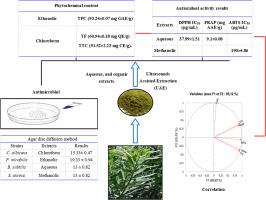达芙妮叶片的植物化学成分、体外抗氧化活性及抗菌活性研究
IF 3.3
Q2 MULTIDISCIPLINARY SCIENCES
引用次数: 0
摘要
达芙妮是地中海盆地的一种特有植物,广泛用于该地区的护发和皮肤病。本研究旨在评价超声辅助提取法提取的牛蒡叶的化学成分,并测定其抗氧化和抑菌活性。乙醇提取物的总酚含量(93.24±0.07 mg GAE/g)较高,氯仿提取物的总黄酮含量(60.94±0.18 mg QE/g)和缩合单宁含量(91.52±2.23 mg CE/g)较高。采用DPPH、ABTS和FRAP三种方法评价其抗氧化能力。水提液在DPPH试验中表现出较强的抗氧化能力(IC50 = 37.99±1.51µg/mL)。ABTS法中乙醇提取物的IC50值最高(190±4.86µg/mL),而FRAP法中水提取物的IC50值最高(9.1±0.08 mg AAE/g)。Pearson相关检验显示,DPPH、ABTS和FRAP法测定的总黄酮含量、缩合单宁含量与抗氧化活性呈正相关,而DPPH、ABTS法测定的总酚含量与总酚含量呈负相关。对金黄色葡萄球菌、枯草芽孢杆菌、奇异变形杆菌和白色念珠菌4种菌株进行了抑菌活性检测。在50 mg/mL浓度下,水提液、甲醇提液、乙醇提液、氯仿提液和乙酸乙酯提液对4种菌株均有抑制作用,抑制直径范围为8.67±0.47 ~ 19.33±0.94 mm,其中乙醇提液对变形杆菌的抑制直径为8.67±0.47 ~ 19.33±0.94 mm。综上所述,龙葵中含有对某些有害细菌具有潜在抗氧化和抗菌活性的化合物。本文章由计算机程序翻译,如有差异,请以英文原文为准。

Phytochemical content, in vitro antioxidants and antimicrobial activities of Daphne gnidium L. leaves
Daphne gnidium is an endemic plant of Mediterranean basin, widely used for hair care and dermatological diseases in this area. This investigation aims to evaluate the phytochemical composition of D. gnidum leaves extracted by ultrasounds assisted extraction using aqueous and organic solvents (methanol, ethanol, chloroform and ethyl acetate) and to determine their antioxidant and antimicrobial activities. The ethanolic extract showed a higher concentration of total phenolic content (93.24 ± 0.07 mg GAE/g of dry extract), while the chloroform extract had a higher flavonoid content (60.94 ± 0.18 mg QE/g of dry extract) and condensed tannins (91.52 ± 2.23 mg CE/g of dry extract). Antioxidant potential was assessed by three methods (DPPH, ABTS and FRAP). Aqueous extract showed stronger antioxidant potential in DPPH test (IC50 = 37.99 ± 1.51 µg/mL). Methanolic extract was the most potent in ABTS assay (IC50 = 190 ± 4.86 µg/mL), while aqueous extract performed best in FRAP method (9.1 ± 0.08 mg AAE/g). The Pearson correlation test revealed a strong positive correlation between total flavonoid content, condensed tannins and antioxidant activity (DPPH, ABTS and FRAP assay), while a negative correlation was demonstrated between the DPPH, ABTS methods and total phenolic content. The antimicrobial activity was examined against four strains (Staphylococcus aureus, Bacillus subtilis, Proteus mirabilis and Candida albicans). At a concentration of 50 mg/mL, all tested extracts (aqueous, methanolic, ethanolic, chloroform and ethyl acetate) exhibited inhibitory effect against the four strains with inhibition diameters ranging from 8.67 ± 0.47 to 19.33 ± 0.94 mm, the latter achieved by the ethanolic extract against Proteus mirabilis. In conclusion, D. gnidium contains compounds with potential antioxidants and antimicrobial activities against certain harmful bacteria.
求助全文
通过发布文献求助,成功后即可免费获取论文全文。
去求助
来源期刊

Scientific African
Multidisciplinary-Multidisciplinary
CiteScore
5.60
自引率
3.40%
发文量
332
审稿时长
10 weeks
 求助内容:
求助内容: 应助结果提醒方式:
应助结果提醒方式:


